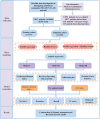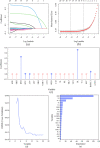Non-alcoholic fatty liver disease risk prediction model and health management strategies for older Chinese adults: a cross-sectional study
- PMID: 38007441
- PMCID: PMC10675849
- DOI: 10.1186/s12944-023-01966-1
Non-alcoholic fatty liver disease risk prediction model and health management strategies for older Chinese adults: a cross-sectional study
Abstract
Background: Non-alcoholic fatty liver disease (NAFLD) is a common chronic liver condition that affects a quarter of the global adult population. To date, only a few NAFLD risk prediction models have been developed for Chinese older adults aged ≥ 60 years. This study presented the development of a risk prediction model for NAFLD in Chinese individuals aged ≥ 60 years and proposed personalised health interventions based on key risk factors to reduce NAFLD incidence among the population.
Methods: A cross-sectional survey was carried out among 9,041 community residents in Shanghai. Three NAFLD risk prediction models (I, II, and III) were constructed using multivariate logistic regression analysis based on the least absolute shrinkage and selection operator regression analysis, and random forest model to select individual characteristics, respectively. To determine the optimal model, the three models' discrimination, calibration, clinical application, and prediction capability were evaluated using the receiver operating characteristic (ROC) curve, calibration plot, decision curve analysis, and net reclassification index (NRI), respectively. To evaluate the optimal model's effectiveness, the previously published NAFLD risk prediction models (Hepatic steatosis index [HSI] and ZJU index) were evaluated using the following five indicators: accuracy, precision, recall, F1-score, and balanced accuracy. A dynamic nomogram was constructed for the optimal model, and a Bayesian network model for predicting NAFLD risk in older adults was visually displayed using Netica software.
Results: The area under the ROC curve of Models I, II, and III in the training dataset was 0.810, 0.826, and 0.825, respectively, and that of the testing data was 0.777, 0.797, and 0.790, respectively. No significant difference was found in the accuracy or NRI between the models; therefore, Model III with the fewest variables was determined as the optimal model. Compared with the HSI and ZJU index, Model III had the highest accuracy (0.716), precision (0.808), recall (0.605), F1 score (0.692), and balanced accuracy (0.723). The risk threshold for Model III was 20%-80%. Model III included body mass index, alanine aminotransferase level, triglyceride level, and lymphocyte count.
Conclusions: A dynamic nomogram and Bayesian network model were developed to identify NAFLD risk in older Chinese adults, providing personalized health management strategies and reducing NAFLD incidence.
Keywords: Bayesian network; Chinese older adults; Health management strategies; Nomogram; Non-alcoholic fatty liver disease.
© 2023. The Author(s).
Conflict of interest statement
The authors declare no competing interests.
Figures






Similar articles
-
Development and validation of a clinical and laboratory-based nomogram to predict nonalcoholic fatty liver disease.Hepatol Int. 2020 Sep;14(5):808-816. doi: 10.1007/s12072-020-10065-7. Epub 2020 Jun 22. Hepatol Int. 2020. PMID: 32572817
-
A clinical and laboratory-based nomogram for predicting nonalcoholic fatty liver disease in non-diabetic adults: a cross-sectional study.Ann Palliat Med. 2022 Jul;11(7):2349-2359. doi: 10.21037/apm-21-2988. Epub 2022 May 10. Ann Palliat Med. 2022. PMID: 35542976 Clinical Trial.
-
Nomogram for predicting the risk of nonalcoholic fatty liver disease in older adults in Qingdao, China: A cross-sectional study.Asia Pac J Clin Nutr. 2024 Mar;33(1):83-93. doi: 10.6133/apjcn.202403_33(1).0009. Asia Pac J Clin Nutr. 2024. PMID: 38494690 Free PMC article.
-
A nomogram incorporated lifestyle indicators for predicting nonalcoholic fatty liver disease.Medicine (Baltimore). 2021 Jul 2;100(26):e26415. doi: 10.1097/MD.0000000000026415. Medicine (Baltimore). 2021. PMID: 34190160 Free PMC article.
-
Factors Associated with Nonalcoholic Fatty Liver Disease in a Non-Overweight/Obese and Overweight/Obese Chinese Population at Risk for Metabolic Syndrome: A Cross-Sectional Multicenter Study.Metab Syndr Relat Disord. 2025 Feb;23(1):41-52. doi: 10.1089/met.2024.0168. Epub 2024 Sep 23. Metab Syndr Relat Disord. 2025. PMID: 39311687
Cited by
-
Relationship Between the ZJU Index and Infertility Risk in Reproductive-Aged US Women: An Analysis of NHANES 2013-2018.Int J Womens Health. 2025 Jul 14;17:2063-2073. doi: 10.2147/IJWH.S527967. eCollection 2025. Int J Womens Health. 2025. PMID: 40689414 Free PMC article.
-
Nomogram for predicting 5-year metabolic dysfunction-associated steatotic liver disease risk: retrospective cohort study.Endocr Connect. 2024 Jul 13;13(8):e240186. doi: 10.1530/EC-24-0186. Print 2024 Aug 1. Endocr Connect. 2024. PMID: 38904472 Free PMC article.
-
Association between life's essential 8 and metabolic dysfunction-associated steatotic liver disease among US adults.Arch Public Health. 2024 Jul 5;82(1):101. doi: 10.1186/s13690-024-01331-3. Arch Public Health. 2024. PMID: 38970079 Free PMC article.
-
Inappropriate Diet Exacerbates Metabolic Dysfunction-Associated Steatotic Liver Disease via Abdominal Obesity.Nutrients. 2024 Dec 5;16(23):4208. doi: 10.3390/nu16234208. Nutrients. 2024. PMID: 39683601 Free PMC article.
References
-
- Cotter TG, Rinella M. Nonalcoholic Fatty Liver Disease 2020: The State of the Disease. Gastroenterology. 2020;158:1851–1864. - PubMed
-
- Makri E, Goulas A, Polyzos SA. Epidemiology, pathogenesis, diagnosis and emerging treatment of nonalcoholic fatty liver disease. Arch Med Res. 2021;52:25–37. - PubMed
-
- Riazi K, Azhari H, Charette JH, Underwood FE, King JA, Afshar EE, Swain MG, Congly SE, Kaplan GG, Shaheen AA. The prevalence and incidence of NAFLD worldwide: a systematic review and meta-analysis. Lancet Gastroenterol Hepatol. 2022;7:851–861. - PubMed
-
- Li J, Zou B, Yeo YH, Feng Y, Xie X, Lee DH, Fujii H, Wu Y, Kam LY, Ji F, et al. Prevalence, incidence, and outcome of non-alcoholic fatty liver disease in Asia, 1999–2019: a systematic review and meta-analysis. Lancet Gastroenterol Hepatol. 2019;4:389–398. - PubMed
MeSH terms
LinkOut - more resources
Full Text Sources
Medical

